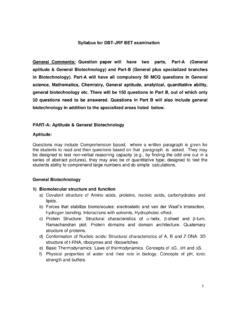Transcription of Guideline on Comparability after a change in the ...
1 European Medicines Agency 7 Westferry Circus, Canary Wharf, London, E14 4HB, UK Tel. (44-20) 74 18 84 00 Fax (44-20) 7418 8613 E-mail: EMEA 2007 Reproduction and/or distribution of this document is authorised for non commercial purposes only provided the EMEA is acknowledged London, 19 July 2007 Doc. Ref. EMEA/CHMP/BMWP/101695/2006 COMMITTEE FOR HUMAN MEDICINAL PRODUCTS (CHMP) Guideline ON Comparability OF BIOTECHNOLOGY-DERIVED MEDICINAL PRODUCTS after A change IN THE MANUFACTURING PROCESS NON-CLINICAL AND CLINICAL ISSUES DRAFT AGREED BY BMWP1 December 2006 ADOPTION BY CHMP FOR RELEASE FOR CONSULTATION January 2007 END OF CONSULTATION (DEADLINE FOR COMMENTS) April 2007 AGREED BY BMWP WORKING PARTY June 2007 ADOPTION BY CHMP July 2007 DATE FOR COMING INTO EFFECT 1 November 2007 This Guideline replaces Guideline on Comparability of medicinal products containing biotechnology-derived proteins as active substance (CPMP/3097/02)
2 [FL2] KEYWORDS Comparability testing, changes in manufacturing procedure, non-clinical, efficacy, pharmacovigilance 2 If this supercedes a previous Guideline otherwise delete EMEA 2007 Page 2/ Guideline ON Comparability OF BIOTECHNOLOGY-DERIVED MEDICINAL PRODUCTS after A change IN THE MANUFACTURING PROCESS NON-CLINICAL AND CLINICAL ISSUES TABLE OF CONTENTS EXECUTIVE SUMMARY .. 3 1. INTRODUCTION .. 3 2. 3 3. LEGAL BASIS .. 4 4. MAIN Guideline TEXT .. 4 REFERENCES .. 10 EMEA 2007 Page 3/ EXECUTIVE SUMMARY Manufacturers of biotechnological/biological products frequently make changes to manufacturing processes of their products both during development and post-approval. Demonstration of Comparability of the pre- and post change product is a sequential process, beginning with quality studies (limited or comprehensive) and supported, as necessary, by non-clinical, clinical and/or pharmacovigilance studies.
3 This Guideline gives advice on the non-clinical and clinical requirements of the Comparability exercise comparing post- change product to pre- change product where manufacturing process changes are made by a single manufacturer, including those made by a contract manufacture. This Guideline will address the requirements for non-clinical and/or clinical bridging studies to demonstrate that the manufacturing change has no impact on safety and efficacy. The selection of non-clinical and clinical studies is product-driven, a strategy for Comparability testing should be chosen that best predicts or detects clinically relevant differences with sufficient accuracy. This Guideline replaces Guideline the Guideline on Comparability of medicinal products containing Biotechnology-derived proteins as active substance (CPMP/3097/02). 1. INTRODUCTION Manufacturers of biotechnological/biological products frequently introduce changes in the manufacturing process of a given product (both before and after the granting of a marketing authorisation).
4 It is assumed that the product s physico-chemical properties and in vitro / in vivo biological activity are well characterised according to state of the art methods. For most changes to the manufacturing process, physico-chemical and (quality related) biological testing can demonstrate that there is no difference in quality of the product that could adversely impact the safety and efficacy of a product. Thus the Comparability exercise may be limited to strict process validation of the change or be extended to various quality criteria such as in-process controls, thorough analytical and biological characterisation of the product and stability data. However, sometimes an effect on efficacy and/or safety can be expected on the basis of observed difference(s)or cannot be ruled out in spite of the state of the art physico-chemical and biological tests. In such cases, additional non-clinical and/or clinical studies will be necessary.
5 The type and extent of such studies are variable and will be dependent on numerous factors related to the drug substance and the drug product, such as knowledge of the molecule and of other molecules of the same class the stage of development of products not yet authorised the findings in the physico-chemical and biological Comparability exercise the intended clinical use. 2. SCOPE The principles adopted and explained in this document apply to proteins and polypeptides, their derivatives, and products of which they are components, , conjugates. These proteins and polypeptides are produced by recombinant or non-recombinant cell-culture expression systems and can be highly purified and characterised using an appropriate set of analytical procedures, in cases when EMEA 2007 Page 4/ Manufacturing process changes are made by a single manufacturer, including those made by a contract manufacturer, who can directly compare the processes, analytical in-process data and results from the analysis of pre- change and post- change product; and Manufacturing process changes are made in development or for which a marketing authorisation has been granted.
6 The principles outlined in this document might also apply to other product types such as proteins and polypeptides isolated from tissues and body fluids. In this case, manufacturers are advised to consult relevant guidelines and the competent Regulatory Authority to determine applicability. 3. LEGAL BASIS This Guideline has to be read in conjunction with the introduction and general principles (4) and part II of the Annex I to Directive 2001/83/EC as amended. 4. MAIN Guideline TEXT Need for non-clinical and clinical studies a risk-based approach Demonstration of Comparability is a sequential process, beginning with quality studies (limited or comprehensive) and supported, as necessary, by non-clinical, clinical and/or pharmacovigilance studies. If a manufacturer can provide evidence of Comparability through physico-chemical and biological studies, then non-clinical or clinical studies with the post- change product are not warranted.
7 In other cases, additional non-clinical and/or clinical data will be required. The need, extent and nature of non-clinical and clinical Comparability studies will be determined on a case-by-case basis in consideration of various factors that may be associated with risk, such as: The process complexity, the nature of the change , the potential impact on the molecule structure and on the final product profile. The nature, and extent of differences demonstrated by the physico-chemical and quality-related biological characterisation, including product-related substances, impurity profile, stability and excipients. Thus, well-characterised differences may provide a background for a rational and focused approach with respect to the need for non-clinical and clinical studies. Product complexity, including heterogeneity and higher order structure and the availability, capabilities and limitations of analytical tests.
8 If the analytical procedures used are not sufficient to discern relevant differences that can impact the safety and efficacy of the product, additional non-clinical and/or confirmatory clinical testing may be necessary. Structure-activity relationship and strength of the association of quality attributes with safety and efficacy; Relationship between the therapeutic protein and endogenous proteins and the severity of (potential) consequences for immunogenicity ; risk of autoimmunity Mode(s) of action: unknown or multiple modes of action complicate the evaluation of the impact of changes therapeutic indications/target patient groups - The impact of possible differences can vary between the target populations covered by the different indications. Posology, , dosing regimen and route of administration, for instance, repeated administration via the subcutaneous route is more likely to be associated with immunogenicity than intravenous administration of a single dose The therapeutic window/dose-response curve Previous experience, , immunogenicity , safety.
9 Experience with the pre- change product or with other products in the same class can be relevant. However, biotechnology-derived proteins should be considered individually. EMEA 2007 Page 5/ For products in development, all these points above should be taken into consideration. However, the extent of the Comparability studies will likely increase if manufacturing changes are introduced at the later stages of clinical development. A change after conduct of confirmatory efficacy and safety studies represents the most challenging situation. The selection of non-clinical and clinical studies is product-driven, a strategy for Comparability testing should be chosen that best predicts and detects clinically relevant differences with sufficient accuracy. Non-clinical data If evidence from physico-chemical studies and quality-related biological studies alone is not sufficient to establish Comparability of the pre- and post- change products, either because these data reveal a difference in the two products, or because the nature of the manufacturing change is such that a difference cannot be excluded based on the available quality data alone, then data from non-clinical studies may provide useful signals of potential therapeutic and safety differences.
10 In some cases it may be appropriate to undertake few or even no non-clinical studies, but in other situations a more detailed evaluation may be helpful. It is important to note that the design of an appropriate non-clinical study program requires a clear understanding of the structure and activity of the product. Relevant guidance documents, notably the Note for guidance on non-clinical safety evaluation of biotechnology derived pharmaceuticals (CPMP/ICH/302/95, March 1998), should be taken into consideration. Changes in the impurity profile would not necessarily trigger non-clinical studies. However the MAH should justify their strategy in this respect. Non-clinical studies should be comparative in nature and should be designed to detect differences in response between the pre- and post- change products and not just the response per se.











